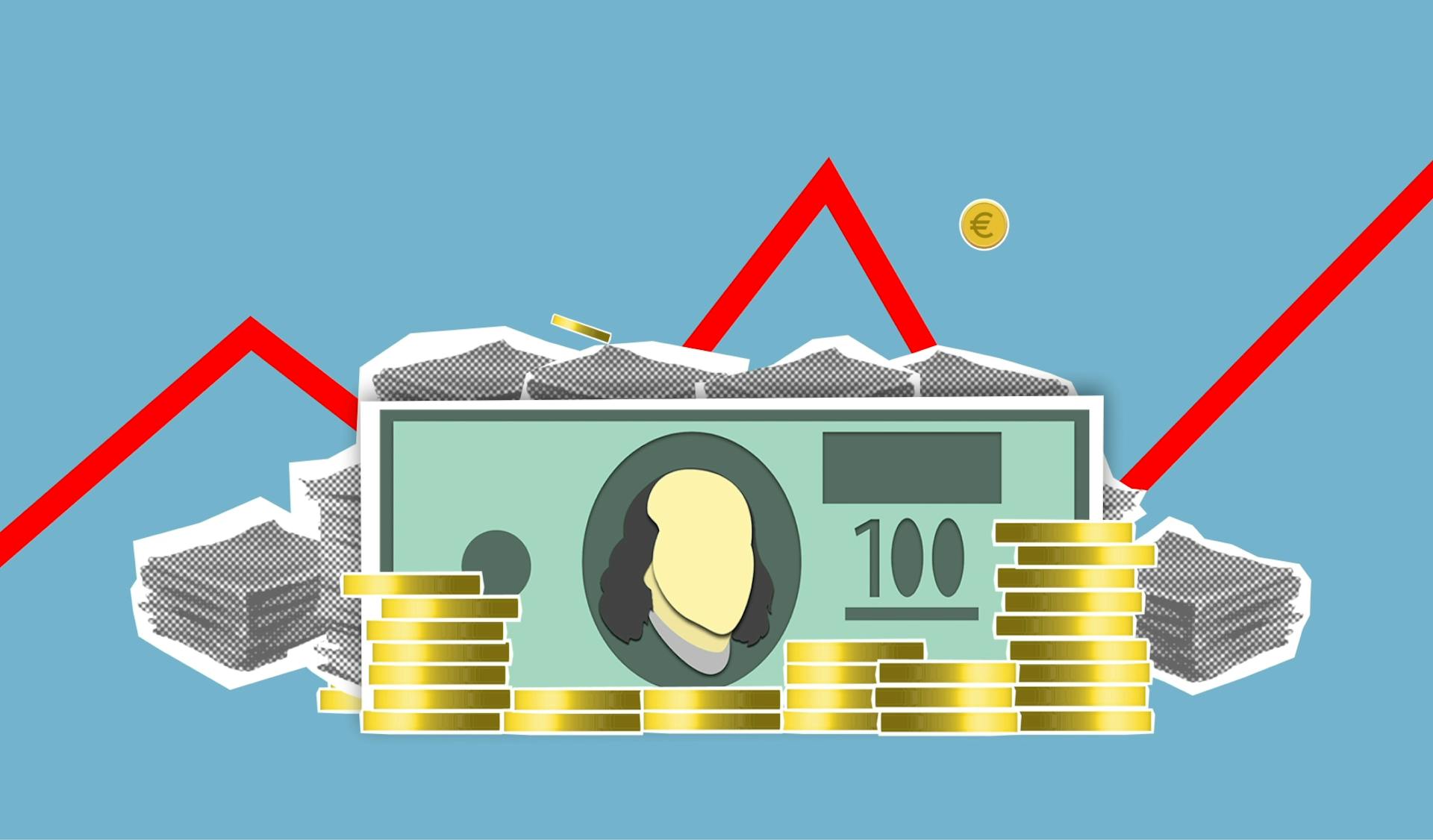
A company's capital structure is like its financial identity card, revealing how it chooses to fund its operations. It's a combination of debt and equity that determines a company's ability to raise capital.
Debt is a type of financing that involves borrowing money from lenders, such as banks or bondholders, with the promise to repay it plus interest. Equity, on the other hand, is ownership in a company, represented by shares of stock.
Companies use a mix of debt and equity to achieve their financial goals, such as funding expansion, paying off debts, or providing a safety net during economic downturns.
Expand your knowledge: Debt and Structured Finance
What is Capital Structure?
Capital structure refers to the amount of debt and/or equity employed by a firm to fund its operations and finance its assets. A firm's capital structure is typically expressed as a debt-to-equity or debt-to-capital ratio.
Debt and equity capital are used to fund a business's operations, capital expenditures, acquisitions, and other investments.
Check this out: Sequoia Capital Fund
A company's capital structure is reflected on its balance sheet. Investors may analyze a company's capital structure on its balance sheet to assess if it's a strong investment.
Debt (from lenders) and equity (via investors) are two of the main ways a company can raise money.
A company's debt typically includes its short-term borrowing, long-term debt, and a portion of the principal amount of operating leases and redeemable preferred stock.
You might like: Capital Account in Balance of Payment
Types of Capital Structure
In a capital structure, there are two main types of capital: debt and equity. Debt investors take less risk because they have the first claim on the assets of the business in the event of bankruptcy.
This means they accept a lower rate of return, resulting in a lower cost of capital for the firm when it issues debt compared to equity.
Equity investors, on the other hand, take more risk, as they only receive the residual value after debt investors have been repaid.
Additional reading: Private Equity or Venture Capital
Components of Capital Structure
A company's capital structure is composed of various types of financing, each with its own characteristics, risks and rewards. This mix of financing options can have a significant impact on a company's financial health and overall success.
The main components of a capital structure include debt and equity. Debt financing, for example, has interest payments and a fixed repayment schedule, whereas equity financing provides no interest payments and no mandatory fixed payments.
Here are the key differences between debt and equity financing:
Components of
A company's capital structure is composed of various types of financing, each with its own characteristics, risks, and rewards.
Debt is a key component, as it gives the firm a lower cost of capital compared to equity. This is because debt investors take less risk and have the first claim on the assets in case of bankruptcy.
Equity investors, on the other hand, take more risk and are last in line to be repaid in case of bankruptcy. As a result, they expect a higher rate of return and have the potential for unlimited upside if the company performs well.
Debt investors accept a lower rate of return due to the lower risk they take on. This makes debt a more attractive option for firms looking to finance their operations.
Here's an interesting read: Return on Capital Employed
Determines
The optimal capital structure of a company is contingent on several factors, which can be broadly categorized into lifecycle, tax-deductibility of interest, business risk, bankruptcy risk, agency costs, and lender risk-appetite.
Corporate lifecycle plays a crucial role in determining the capital structure of a company. Early-stage companies tend to avoid traditional debt due to high-risk profiles, whereas later-stage companies often have more debt on their balance sheet.
Tax-deductibility of interest can also impact a company's capital structure. The tax savings from interest expense can initially increase the firm's valuation, but the risk of default eventually offsets these benefits.
Business risk is another significant factor, with companies having higher business risk often opting for less financial leverage. This is because business risk can lead to increased debt servicing costs, making it harder for the company to meet its financial obligations.
Bankruptcy risk is also a critical consideration, with lenders offering favorable terms to borrowers with low credit risk. Conversely, companies with high credit risk may struggle to access debt at reasonable rates.
Expand your knowledge: Growth Capital Company
Agency costs can also affect a company's capital structure, particularly when there are discrepancies between management and stakeholders. This can lead to losses and a reduction in valuation, making it essential for companies to manage agency costs effectively.
The table below summarizes the key factors that determine a company's optimal capital structure:
How to Recapitalize
Recapitalizing a business involves changing the mix of debt and equity in its capital structure. This can be done in various ways, but three effective methods are available.
Issuing debt and repurchasing equity is one approach. By borrowing money and using it to buy back shares, a firm can increase its debt and decrease its equity on the balance sheet. This can be a good option for a firm that wants to shift towards a more debt-heavy capital structure.
Issuing debt and paying a large dividend to equity investors is another approach. This involves borrowing money and using it to pay a one-time special dividend, which reduces the value of equity by the value of the dividend.
Check this out: Capital One 360 Joint Account
Issuing equity and repaying debt is a third approach. However, this is not always the most desirable option, as equity is generally costlier than debt. It's often only done when a firm is overleveraged and desperately needs to reduce its debt.
Here are the three recapitalization methods summarized:
Calculating Capital Structure
Calculating Capital Structure is a crucial step in determining a company's optimal mix of debt and equity. A lower Weighted Average Cost of Capital (WACC) causes a firm's valuation to increase, while a higher WACC leads to a lower valuation.
The optimal capital structure is the balance between the benefits of using leverage, such as tax-deductibility of interest expense and lower cost of debt relative to equity, and the risk of defaulting on financing obligations. This trade-off is key to minimizing the WACC and maximizing firm valuation.
To calculate the proportion of debt and equity in a company's capital structure, you can use the debt-to-equity ratio formula: Total debt / Total equity. For example, a company with $50 million in total debt and $100 million in total equity has a debt-to-equity ratio of 0.5 or 50%.
Suggestion: The Capital Adequacy Ratio
The debt-to-equity ratio is a simple yet effective way to assess a company's capital structure. It's calculated by dividing total debt by total equity. Here's a breakdown of the formula:
- Total debt = Short-term debt + Long-term debt
- Total equity = Shareholders' equity (including common stock, preferred stock, and retained earnings)
By understanding and calculating capital structure, management teams can make informed decisions to maximize firm value and minimize the WACC.
Additional reading: A B Capital Share Price
Factors Affecting Capital Structure
The capital structure of a company is influenced by several key factors, including its ability to generate free cash flow, which must be sufficient to cover debt service obligations on time.
A company's historical profitability and generation of free cash flow can also contribute to its sustainable economic moat, leading to a greater proportion of debt on its capital structure.
Companies with a significant fixed asset base can secure debt financing more easily, as lenders can seize the pledged collateral in the event of default.
The reliance on intangible assets can make it less likely for management to use debt as a funding source, as these assets cannot be pledged as collateral.
In fact, a higher debt-to-equity ratio can create an incentive for management to undertake risky projects, as debtors experience the downside if the project is unsuccessful.
The following factors affect the capital structure decision among corporations:
- Free Cash Flow (FCF)
- Economic Moat
- Historical Profitability
- Collateral (Fixed Asset Base)
- Tangible Assets
Agency Costs
Agency costs arise when there's a mismatch between the interests of shareholders and those of management. This can lead to suboptimal decision-making.
One type of agency cost is the asset substitution effect, where management takes on riskier projects to benefit shareholders, but leaves debtors to bear the losses. Think of it like a gamble where the house always wins, except in this case, it's the shareholders who win if the project succeeds.
As debt-to-equity ratio increases, management's incentive to undertake such projects also increases. This can lead to a situation where the firm takes on too much risk, potentially harming its value.
Another agency cost is the underinvestment problem, where management rejects positive NPV projects because the gains would go to debt holders rather than shareholders. This can be seen in growth companies with high levels of debt, where management may prioritize short-term stability over long-term growth.
A third agency cost is the free cash flow problem, where management has an incentive to destroy firm value through empire building and perks if they're not held accountable. Increasing leverage can impose financial discipline on management, forcing them to prioritize firm value over personal gain.
You might enjoy: Ltcm
Here are the three types of agency costs in summary:
- Asset substitution effect: Management takes on riskier projects to benefit shareholders, leaving debtors to bear the losses.
- Underinvestment problem: Management rejects positive NPV projects because the gains would go to debt holders rather than shareholders.
- Free cash flow problem: Management has an incentive to destroy firm value through empire building and perks if they're not held accountable.
Macroeconomic Conditions
Macroeconomic conditions have a significant impact on capital structure choice. Researchers have found that equity issues cluster following a run-up in the equity market, as seen in Korajczyk, Lucas, and McDonald's (1990) study.
Favorable macroeconomic conditions can make it easier for firms to issue equity, but constrained firms may not be able to time their issue choice accordingly. Korajczyk and Levy (2003) found that target leverage is counter-cyclical for unconstrained firms, but pro-cyclical for firms that are constrained.
The business cycle can also affect the trade-offs between agency problems and risk sharing, leading to observed patterns in capital structure choice. Levy and Hennessy (2007) highlighted this relationship, which can result in asset pricing puzzles.
Here's a summary of the macroeconomic conditions affecting capital structure choice:
Factors Affecting Decision
Free cash flow plays a crucial role in determining a company's capital structure. It must be sufficient to cover debt service obligations on time.
A company's historical profitability is another key factor. A consistent track record of generating free cash flow and profits can carve a sustainable moat, contributing to long-term profits and market share protection.
The economic moat of a market leader can also influence capital structure. Companies with a sustainable economic moat tend to carry a greater proportion of debt on their capital structure.
Tangible assets can also impact capital structure decisions. Companies with a significant fixed asset base can secure debt financing more easily, as lenders can seize the collateral in the event of default.
Intangible assets, on the other hand, can make it harder for companies to use debt as a funding source. Unlike tangible assets, intangible assets cannot be pledged as collateral.
Here are the factors affecting capital structure decision in a concise list:
- Free Cash Flow (FCF)
- Economic Moat
- Historical Profitability
- Collateral (Fixed Asset Base)
- Tangible Assets
Theories of Capital Structure
Capital structure theories attempt to explain how companies make financing decisions. The trade-off theory suggests that companies balance the benefits of debt financing, such as tax shields, against the costs, including bankruptcy and financial distress costs.
Readers also liked: What Is Venture Capital Financing
A company's capital structure is a result of a trade-off between costs and benefits, with the marginal benefit of debt declining as debt increases. The pecking order theory proposes that companies prioritize internal financing, then debt, and finally equity, due to the costs of asymmetric information.
The Modigliani-Miller theorem states that, in a perfect market, a company's capital structure is irrelevant to its value. However, this theory has been criticized for ignoring real-world imperfections, such as taxes and information asymmetry, which can affect a company's capital structure.
Related reading: Trade-off Theory of Capital Structure
Modigliani-Miller Theorem
The Modigliani-Miller theorem, proposed by Franco Modigliani and Merton Miller in 1958, forms the basis for modern academic thinking on capital structure.
In a perfect market, the theorem states that how a firm is financed is irrelevant to its value. This is because it disregards many important factors in the capital structure process, such as fluctuations and uncertain situations that may occur in the course of financing a firm.
The theorem assumes a perfect capital market with no transaction or bankruptcy costs, perfect information, and investment returns not affected by financial uncertainty. This is a mirage, as suggested by Modigliani and Miller, and is unattainable.
Modigliani and Miller made two key findings under these conditions. Their first proposition was that the value of a company is independent of its capital structure. Their second proposition stated that the cost of equity for a leveraged firm is equal to the cost of equity for an unleveraged firm, plus an added premium for financial risk.
Debt investors take less risk because they have the first claim on the assets of the business in the event of bankruptcy, accepting a lower rate of return in the process. This results in a lower cost of capital for the firm when it issues debt compared to equity.
The cost of capital decreases as the proportion of debt in the capital structure increases, making debt financing valuable under a classical tax system. The optimal structure would be to have virtually no equity at all, consisting of 99.99% debt.
For your interest: Capital Cost Allowance
Trade-off Theory
The trade-off theory of capital structure suggests that companies balance the benefits and costs of using debt and equity financing. This theory highlights the importance of considering both the tax benefits of debt and the costs associated with it, such as bankruptcy costs and financial distress costs.
Companies use debt and equity financing by weighing the marginal benefits and costs of each. The marginal benefit of increasing debt declines as debt increases, while the marginal cost increases.
Empirical studies have found that the trade-off theory may explain differences in debt-to-equity ratios between industries, but it doesn't explain differences within the same industry. This suggests that industry-specific factors play a role in determining capital structure.
Consider reading: Stages of Venture Capital Financing
Pecking Order Theory
The Pecking Order Theory suggests that companies prefer to raise capital from internal sources, followed by debt, and finally equity. This is because internal financing is seen as the most convenient option.
According to Myers (1984), managers prefer to issue debt over equity because investors view new equity issuances as a sign that managers think their company is overvalued. This can lead to a lower valuation of the new equity.
Companies follow a hierarchy of financing sources, with internal financing being the first choice, followed by debt, and then equity. This is because equity issuance brings external ownership into the company.
The Pecking Order Theory assumes that managers have better knowledge of their company's true condition than investors, which is why they prefer to issue debt over equity.
Cost of Equity vs. Cost of Debt
The cost of equity and cost of debt are two fundamental concepts in finance that help companies determine their optimal capital structure. The cost of debt is initially lower than the cost of equity because interest expense is tax-deductible.
Equity shareholders, on the other hand, are not guaranteed any income and are last in line to receive funds in the event of default and liquidation. This makes their cost of capital higher.
Debt issuances cause financial risk to rise because they impose a fixed cost in the form of interest payments and/or mandatory principal amortization. Loan covenants can also restrict a company's operational flexibility.
Intriguing read: Capitalize Interest
The cost of equity is greater than that of debt because equity investors take more risk, as they only receive the residual value after debt investors have been repaid. This implies a higher cost of equity.
Here's a comparison of the characteristics of debt and equity:
Sources
- https://en.wikipedia.org/wiki/Capital_structure
- https://www.wallstreetprep.com/knowledge/optimal-capital-structure/
- https://corporatefinanceinstitute.com/resources/accounting/capital-structure-overview/
- https://www.investopedia.com/terms/c/capitalstructure.asp
- https://www.moonfare.com/glossary/capital-structure
Featured Images: pexels.com


